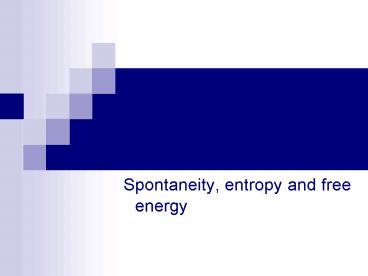Spontaneity, entropy and free energy PowerPoint PPT Presentation
1 / 13
Title: Spontaneity, entropy and free energy
1
Chapter 16
- Spontaneity, entropy and free energy
2
Spontaneous
- A reaction that will occur without outside
intervention. - We cant determine how fast.
- We need both thermodynamics and kinetics to
describe a reaction completely. - Thermodynamics compares initial and final states.
- Kinetics describes pathway between.
3
Thermodynamics
- 1st Law- the energy of the universe is constant.
- Keeps track of thermodynamics doesnt correctly
predict spontaneity. - Entropy (S) is disorder or randomness
- 2nd Law the entropy of the universe increases.
4
Entropy
- Defined in terms of probability.
- Substances take the arrangement that is most
likely. - The most likely is the most random.
- Calculate the number of arrangements for a system.
5
- 2 possible arrangements
- 50 chance of finding the left empty
6
- 4 possible arrangements
- 25 chance of finding the left empty
- 50 chance of them being evenly dispersed
7
Gases
- Gases completely fill their chamber because there
are many more ways to do that than to leave half
empty. - Ssolid ltSliquid ltltSgas
- there are many more ways for the molecules to be
arranged as a liquid than a solid. - Gases have a huge number of positions possible.
8
DS
- DS S final - S initial
- If DS is positive, then the system has become
more disordered. - If DS is negative, then the system has become
less disordered, more ordered.
9
Entropy
- Solutions form because there are many more
possible arrangements of dissolved pieces than if
they stay separate. - 2nd Law
- DSuniv DSsys DSsurr
- If DSuniv is positive the process is spontaneous.
- If DSuniv is negative the process is only
spontaneous in the opposite direction.
10
Example
- Predict whether the DS is likely to be positive
or negative for each of the following reactions. - H2CCH2(g) Br2(g) ? CH2BrCH2Br(l)
- 2C2H6(g) 7O2(g) ? 4CO2(g) 6H2O(l)
11
Temperature and Spontaneity
- Entropy changes in the surroundings are
determined by the heat flow. - An exothermic process is favored because by
giving up heat the entropy of the surroundings
increases. - The size of DSsurr depends on temperature
- DSsurr -DH/T
12
Gibb's Free Energy
- Being able to look at enthalphy (H) and
entropy(S) together to see if a reaction is
spontaneous - DGDH-TDS
- If DG 0 the process is spontaneous
- If DG 0 the process at equilibrium
- If DG 0 the process is nonspontaneous
13
Lets Check
- For the reaction H2O(s) H2O(l)
- DSº 22.1 J/K mol DHº 6030 J/mol
- Calculate DG at 10ºC and -10ºC
- Look at the equation DGDH-TDS
- Spontaneity can be predicted from the sign of DH
and DS.

